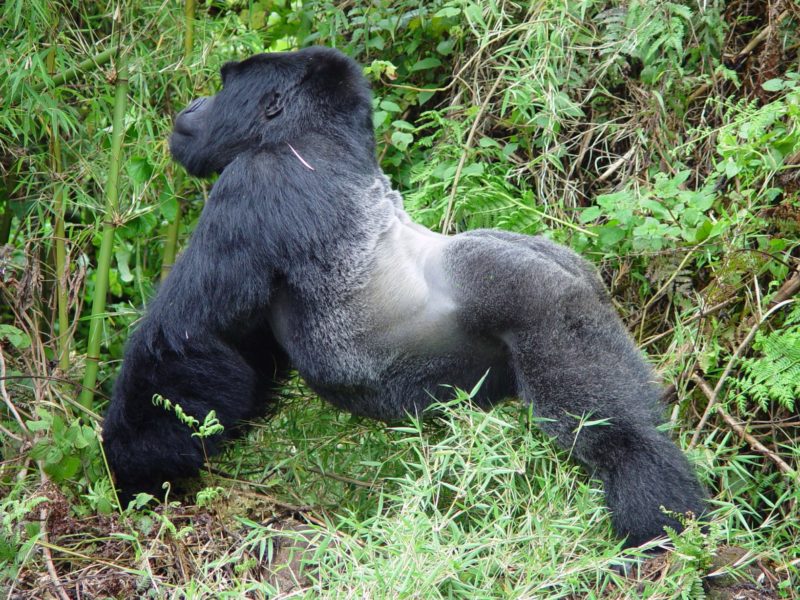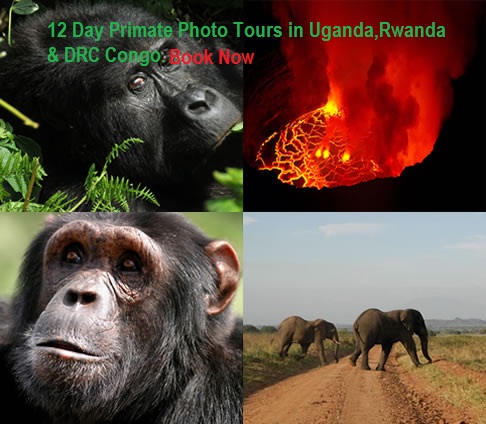This gorilla safari will take you to the 3 distinguished gorilla destinations in Africa. On arrival at the airport, you are picked by our driver/guide for briefing and overnight at your preferred hotel.
Photographing gorillas is very exciting because they are one of our closest relatives. Even though many question whether gorilla trekking is ethical or not, observing them in the wild should be undertaken by everyone at some point in their lives.
Gorilla tracking involves hiking deep into Africa’s jungles in search of the primates. Finding them is 100% guaranteed because a group of advance trackers are sent earlier to find their exact location. The guide and rangers moving with tourists will be in constant communication with the advance trackers in order to know the best route to use. Once you find the gorillas, the Rangers will study their mood before allowing tourists to start taking photos and videos.
Getting good images of the primates is what every tourist hopes for whenever they book a gorilla tour. There are about 21 habituated gorilla groups in Uganda, 12 in Rwanda and 06 in Congo. Each gorilla group is special and has a different composition of individuals. Some have more individual gorillas, more silver backs, more breastfeeding mothers and more infants. You need to let your tour company know about your preferences so that they can arrange for you to track a gorilla group of your choice.
Taking photos of gorillas can be easy, complicated or even frustrating depending on the location of the group and overall terrain. The tropical rains, thick forests and resulting low light conditions may also present a challenge for inexperienced photographers. It is also important to note that gorillas are generally shy primates. Because they don’t maintain direct eye contact for long, improvisation and a good camera will be important for you want to get a variety of facial expressions.
Tropical forests receive rain even during the dry season. You should therefore ensure that you have protection for your cameras and related equipment; a rain-proof bag will come in handy and help protect your cameras from any damages. Also remember to travel with enough memory cards and batteries for the camera.
You cannot predict the circumstances under which you will find the primates. Gorillas sometimes move from one place to another as they foliage. A camera with telephoto lens can help you photograph gorillas even when they are far away. Lenses that are 200mm to 300mm are good enough for close distance photography but we recommend those of a 400mm range to get perfect shots regardless of the distance between you and the primates.
In order to get the best shots, you will need to take several shots at once. The camera needs to be set up correctly to get perfect shots. It is important to remember that mountain gorillas are large creatures with black fur. The green environment and dark coat can confuse light coming out of some cameras if not well set. Set your camera correctly to avoid overexposure.
Go with a second camera: Ensure that the second camera is of a different type so that you have two different lenses with different final products for comparison.
Travel with a light weight camera. Gorilla tracking can take between 2 to 6 hours to complete depending on the location of the gorilla family you would be following. Do not worry if you have very heavy cameras. All the gorilla parks have porters who help tourists carry any heavy bags and equipment at a small fee of about $15.
While taking photos of mountain gorillas, it is always important to follow instructions from park guides. Remember the gorilla trekking rules such as keeping a distance of at least 7 meters, avoiding prolonged direct eye contact and standing taller than the primates when they get close to you.
Transfer to the gorilla-trekking base in the rain forest. The park, whose name aptly references the dense forests it encompasses, is home to roughly half the world’s remaining mountain gorillas. Though best known for its outstanding gorilla tracking, it also provides refuge to chimpanzees, monkeys, elephants and various small antelope. Bwindi is also a key Uganda birding destination, with 23 of Uganda’s 24 Albertine Rift endemics, including threatened species such as African green broad bill and Shelley’s crimson wing.
Discover one of nature travel’s peak experiences. The safari includes two chances to spend time among the gorillas, maximizing prospects for extraordinary photographs, often at very close range. Early in the morning, we depart on a trek through the dense rain forest on a quest to locate one of the “habituated” family groups.
Our local guides are expert trackers, reading signs of the gorillas’ recent presence in the undergrowth. Finally, we hear and see them, and watch, enrapt as they sit in the trees chewing leaves, babies clinging to mothers’ backs, juveniles swinging from branches and a big male silver back surveying it all. It’s hard to tell who is more captivated, the gorillas or us! If time permits, we’ll visit Conservation Coffee, a local co-op of farmers who grow process and roast beans to sell at a premium that benefits gorilla conservation.
Leaving Bwindi, we descend to the Rift Valley floor, photographing scenes of local villages and coffee plantations en-route. Entering Rwanda, continue to Parc National des Volcans. The park is one of three areas where mountain gorillas reside. Our destination, Five Volcanoes, is a deluxe boutique lodge that provides an ideal gorilla trekking base for the next three nights. Set seamlessly into its lush surroundings with panoramic vistas of the mountains beyond, the lodge is just a short drive from the national park headquarters, where all gorilla trekking expeditions depart.
Head to the park headquarters for a briefing from the guides. This area is where Dian Fossey made her ground-breaking studies on mountain gorillas before she was killed in 1985, and her grave is nearby. Several habituated gorilla families live in the park, and we learn how important our ecotourism presence is to their survival before we trek in search of them.
We set out early each morning along paths into the forest, eventually leaving trails behind as our trackers follow signs that lead them to the gorillas’ current location. The altitude is above 8,200 feet, so while our pace is unhurried, the hike is tiring, lasting from 30 minutes to several hours.
But what a reward: the chosen destination is a specific group of habituated gorillas which have become used to visitors and behave normally, nonchalant about human presence. With a full hour to sit with a gorilla troop, we are able to capture extraordinary photographs.
Transfer to Democratic Republic of Congo. Gorillas in Democratic Republic of Congo can be photographed in Virunga National Park for mountain gorilla trekking or Kahuzi Beiga National Park for Low Land Gorilla trekking.
Both Virunga and Kahuzi Beiga National Parks experience the same weather, with this both national Parks are prone to receiving uncertain rains any time of the day or week, good months to visit Congo for gorilla trekking are dry season months which occurs in the months of December, January, February, June, July, August and September during these months it always easy to walk through the trails which are drier compared to the wet months then as well the vegetation is not fully grown and this makes sighting and photographing of gorillas easy and more clear.

